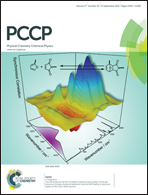Hydrogen-bonding interactions of uric acid complexes with water/melamine by mid-infrared spectroscopy†
Abstract
Hydrogen (H)-bonding interactions of uric acid (UA) with water have been investigated via IR-UV double resonance measurements in the mid-IR region. Comparison of the present results with those obtained previously in the near-IR region enables us to examine microscopic hydration effects that are specific to the H-bonding acceptor sites of UA. It is shown that hydration of the C8O site promotes the mode coupling of this stretch with the C2O stretch. The occurrence of this coupling is manifested in the IR intensity pattern, in which the transition associated with the in-phase contribution C8O + C2O is significantly suppressed, whereas the corresponding out-of-phase contribution gives rise to a strong peak. We also measured the mid-IR spectra of the 1 : 1 complex formed between UA and melamine (MEL) and carried out a structural analysis using the spectroscopic signature of the H-bonding derived from the result of the monohydrated cluster. It is shown that the complex possesses a triple H-bonding structure with the C2O acceptor site of UA H-bonded to MEL. Furthermore, the IR-depleted UV spectroscopy technique was employed in order to ascertain whether other structural isomers are present in the probe UV spectra.


 Please wait while we load your content...
Please wait while we load your content...